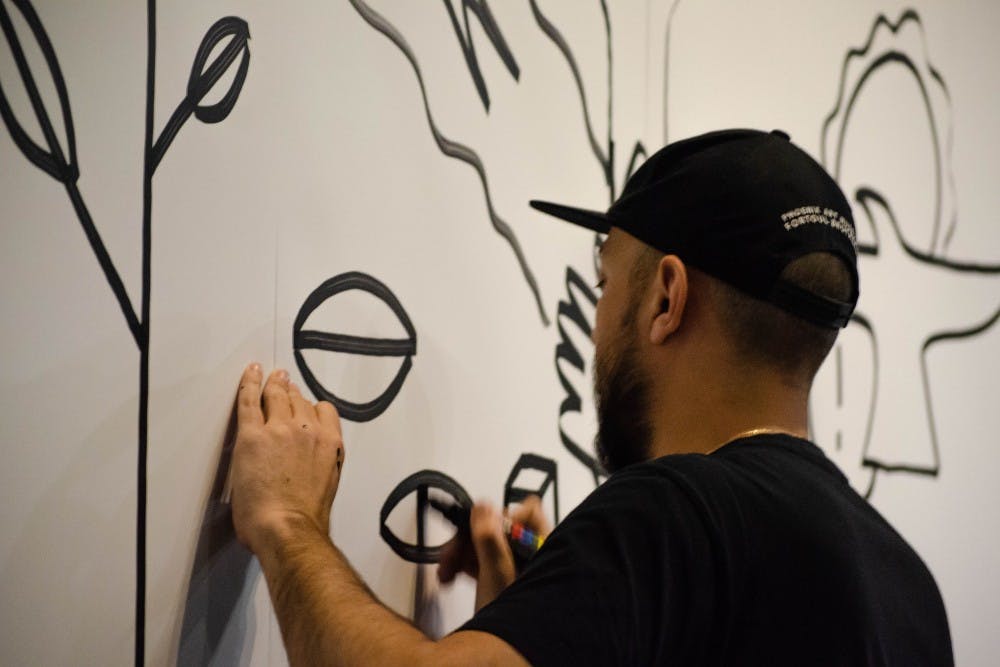As a thick, black marker slid and swirled around poster paper taped to the wall of the Design School bridge, students from all backgrounds witnessed and collaborated in the first planning session for a new mural that will celebrate minority groups in architecture.
ASU's Latino Architecture Student Organization (LASO), which is a Herberger Institute for Design and the Arts initiative to offer a space for Latinx architecture students to come together, plans on painting the walls of the Design North student center to help break down the walls of the predominantly white field of architecture.
The group met on Wednesday on the Design School bridge to brainstorm ideas for the narrative behind the new mural. The panel was lead by the Fortoul brothers, a pair of prominent Columbian artists.
Ben Lyons, a senior studying architecture and the founder of LASO, said that he is excited for LASO to make their first permanent mark on the school by creating the "intricate, powerful mural" on the Design North student center.
“By creating the mural, we have the ability to create a narrative for our idea of the future of design education,” Lyons said. “With this narrative, we can have this place that’s permanent for students and have a bit of storytelling as we do that.”
The two-year-old organization was formed with goals to increase Latinx/minority retention in the field of architecture and create a safe community for everyone, Lyons said.
LASO is not limited to Latinx architecture students, but welcomes all students within the school, he said.
“Because architecture and design are both fields that are widely dominated by white heterosexual men, (LASO) was created to challenge that while creating the network and providing the tools to help students succeed in this predominantly white field,” Lyons said.
Racial and Ethnic Diversity Improves Among Licensure Candidates by NCARB
Mia Salazar, a sophomore studying architecture, is the design build president of LASO.
Salazar said that the organization has helped her feel more comfortable in the architecture community as a Latinx student ever since she joined as a freshman.
“There weren’t a lot of Latinos in the architecture program itself, and I didn't know anyone at ASU,” Salazar said. “Being a part of LASO, I was brought closer with people in my community and my culture. We just became a huge family, and that’s what we hope to bring to other students.”
The mural will be painted in collaboration with the Fortoul brothers, who will help students gain knowledge on how to apply their skills outside of the classroom.
Gabriel Fortoul, one of the two Fortoul brothers, said the project will provide students with hands on knowledge while creating unity at the University.
“We want to use this as more of an opportunity for students to work with other students and get that interaction to conceive a unified vision,” Fortoul said. “Whatever energy you’re trying to project, public art is the best way to do that.”
The artist spoke on Wednesday about the care that goes into creating art for minorities.
"Intuition is a very delicate fiber that needs the utmost care," Fortoul said. "Creating art is not a job or an activity, but it is a way of life."
Fortoul said that he hopes the mural will bring attention to the importance of education in design and arts.
“I think this is significant in that it’s going to strike up conversation, (and) it’s an opportunity to inspire,” he said. “You might not necessarily believe there’s a career in visual arts, but the more you see successful artists, you see the option is there.”
Lyons said the mural will consist of three large panels done by the Fortoul brothers with a narrative designed by the students. It will extend from those canvasses onto the wall, painted by the students.
“It’s an opportunity to bring in more Latino professionals for people to learn from,” Lyons said. “The reason we’re having the Fortoul brothers do it on canvas is because those become a point of value for the school.”
Fortoul said viewers can stay updated with the mural process by visiting the LASO instagram page.
“This project itself is for everyone,” Fortoul said. “They’re breaking form barriers."
He said that this inclusive project ties art as self expression to the voice of minority groups.
"We believe everyone is capable of creating art of some sort," Fortoul said. "Art is a continuous search for the truth of the essence of life."
Reach the reporter at ivcrespo@asu.edu or follow @ziacrespo on Twitter.
Like The State Press on Facebook and follow @statepress on Twitter.




